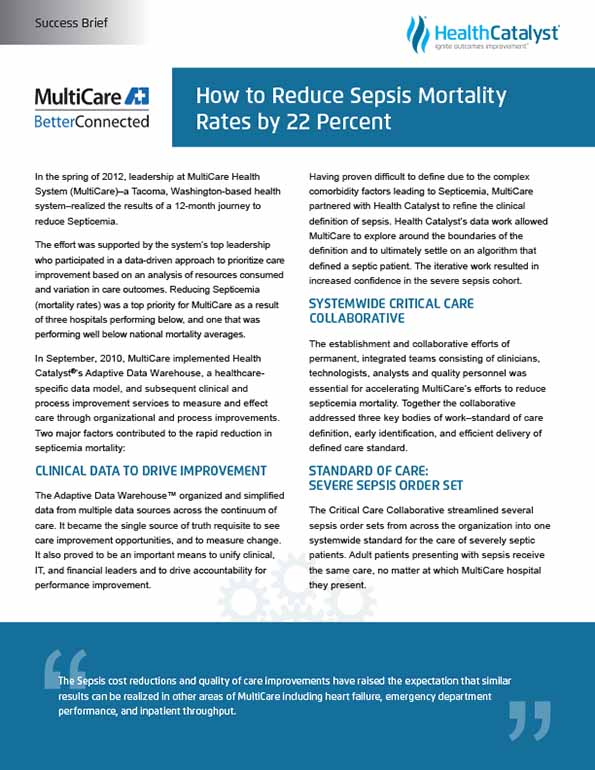Multicare reduced sepsis by 22 percent, resulting in $1.3 million in cost savings. The organization is now addressing other areas for improvement. Discover what triggered these enhancements and how they led to savings.
In the spring of 2012, leadership at MultiCare Health System (MultiCare)—a Tacoma, Washington-based health system—realized the results of a 12-month journey to reduce Septicemia.
The effort was supported by the system’s top leadership who participated in a data-driven approach to prioritize care improvement based on an analysis of resources consumed and variation in care outcomes. Reducing Septicemia (mortality rates) was a top priority for MultiCare as a result of three hospitals performing below, and one that was performing well below national mortality averages.
In September, 2010, MultiCare implemented Health Catalyst’s Adaptive Data Warehouse, a healthcare-specific data model, and subsequent clinical and process improvement services to measure and effect care through organizational and process improvements. Two major factors contributed to the rapid reduction in septicemia mortality:
The Adaptive Data Warehouse™ organized and simplified data from multiple data sources across the continuum of care. It became the single source of truth requisite to see care improvement opportunities, and to measure change. It also proved to be an important means to unify clinical, IT, and financial leaders and to drive accountability for performance improvement.
Having proven difficult to define due to the complex comorbidity factors leading to Septicemia, MultiCare partnered with Health Catalyst to refine the clinical definition of sepsis. Health Catalyst’s data work allowed MultiCare to explore around the boundaries of the definition and to ultimately settle on an algorithm that defined a septic patient. The iterative work resulted in increased confidence in the severe sepsis cohort.
The establishment and collaborative efforts of permanent, integrated teams consisting of clinicians, technologists, analysts and quality personnel was essential for accelerating MultiCare’s efforts to reduce septicemia mortality. Together the collaborative addressed three key bodies of work – standard of care definition, early identification, and efficient delivery of defined care standard.
The Critical Care Collaborative streamlined several sepsis order sets from across the organization into one system-wide standard for the care of severely septic patients. Adult patients presenting with sepsis receive the same care, no matter at which MultiCare hospital they present.
MultiCare developed a modified early warning system (MEWS) dashboard that leveraged the cohort definition and the clinical EMR to quickly identify patients who were trending towards a sudden downturn. Hospital staff constantly monitors MEWS which serves as an early detection tool for caregivers to provide preemptive interventions.
The final key piece of clinical work undertaken by the Collaborative was to ensure timely implementation of the defined standard of care, to patients who are more efficiently identified. That model already exists in healthcare and is known as the ‘code’ process. Similar to other ‘code’ processes (code trauma, code neuro, code STEMI), code sepsis at MultiCare is designed to bring together essential caregivers, in order to efficiently deliver time-sensitive, life-saving treatments to the patient presenting with severe sepsis.
In just twelve months, MultiCare was able to reduce septicemia mortality rates by an average of 22 percent, leading to more than $1.3M in validated cost savings during that same period. The Sepsis cost reductions and quality of care improvements have raised the expectation that similar results can be realized in other areas of MultiCare including heart failure, emergency department performance and inpatient throughput.
Reduction of septicemia mortality rates: 22 percent. MultiCare was able to reduce septicemia mortality rates by an average of 22 percent.
Resulting cost savings: $1.3M. The reduction in sepsis costs resulted in a validated cost savings of $1.3M over the 12 month period.


